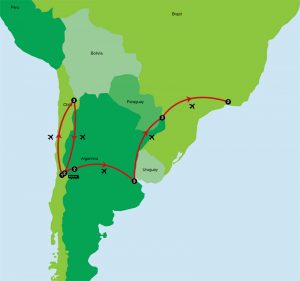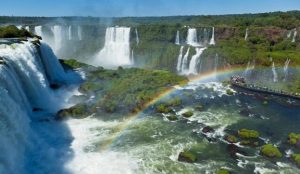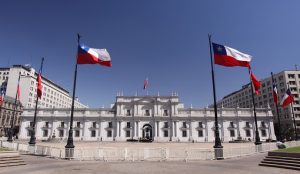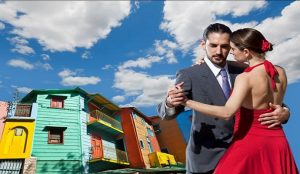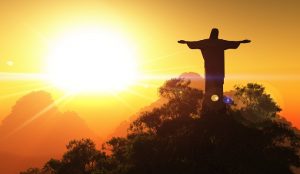 Print Itinerary
Print Itinerary
-
- All Accommodation & Breakfasts
- All Transfers
- Over 7 Different Day tours
- Both Sides of Iguassu Falls
- And much more….
Day 1 SANTIAGO (B)
Arrival in Santiago and transfer to the hotel.
Day 2 SANTIAGO – ATACAMA (B)
Transfer to the airport for the flight to Calama (not included). Arrival and reception by our local tour guide, transfer of approx. 1 ½ hours to San Pedro de Atacama.
In the afternoon half day city walk of San Pedro de Atacama. The is the most important archaeological centre in Chile situated 2,438 metres above sea level and surrounded by a green fertile picturesque oasis. San Pedro was the centre of a Paleolithic civilization. With its narrow streets that have been preserved with its old style dating back to the Spanish conquerors and its beautiful colonial church that was built in 1577. The village is the centre for Indian culture in the Atacama Desert. Artifacts have been recovered and are now displayed in the Father Le Paige Museum, which you will visit during the walking tour. There are over 4,000 skulls; weapons and stone sand potteries that are found on display. Afterwards, you will visit the beautiful white church in the town, which has been partly constructed of cactus.
Right on time for the beautiful sunset, you will drive to the Moon Valley in the late afternoon. It fascinates with silence, moonscape and the snow-capped volcanoes in the background. The last sun rays reaching the ground colour the valley in shining orange, red and purple hues. Don’t miss this unique experience!
Day 3 SAN PEDRO DE ATACAMA (B)
Today you will start your tour visiting the huge Atacama Salt Lake, an inland sea dating back millions of years. Enjoy a unique experience viewing this doubtlessly driest desert in the world. The flatness, clearness and emptiness here are overwhelming. Following the road in direction to Argentina, you will get to know the Lagunas Miscanti & Meñiques, set at the base of two immense volcanoes. These alti-plane lakes are fringed with salt deposits and surrounded by brilliantly colored clumps of “paja brava”, creating a singular visual experience. Afterwards you continue to the small Indian village of Toconao. The inhabitants of Toconao are producing beautiful small sculptures out of a white volcanic stone that can be found in a quarry near the village. Return to the hotel.
Day 4 SAN PEDRO DE ATACAMA (B)
Full day at leisure. Optional tours can be booked at our local office.
Optional: Excursion to visit El Tatio
Early in the morning (04:00 AM) you will depart for a drive 125 kms northeast to visit the impressive Tatio Geysers at an altitude of 4.321m! The steaming geysers are at their best between 06:30am and 08:30am.
Day 5 SAN PEDRO DE ATACAMA – SANTIAGO (B)
Transfer to Calama airport to board your flight to Santiago (not included).
Arrival in Santiago and transfer to the hotel.
At the beginning of the city tour you will see the San Francisco church, which was built between 1572 and 1618. You will pass through the Barrio Paris & London which is characterized by its European architectural style and its’ narrow cobbled streets. Then you will visit the Club Hípico, one of the most beautiful horseracing tracks in South America, privileged by its architecture of the late 19th century.
Continuing your tour towards the Barrio Concha y Toro, you will immediately notice that the constructions of the buildings here are very similar to those in the Barrio Paris y London. While walking through the main street you will recover vestiges of the aristocratic past of the capital. In 1989 this district was declared as “Zona Tipica” (typical zone). You will be impressed by the gothic, neo-colonial and Bauhaus constructions. After that you will visit the Plaza de Armas and see the cathedral. Just around the corner, you will find the main post office, the National History museum and the town hall of Santiago. From here you head along the famous Alameda, Santiago’s colourful main avenue, towards the heart of the city, seeing the “Palacio de la Moneda” (seat of government), various monuments and public buildings on the way. Afterwards, you continue the tour by driving up to the top of the San Cristóbal Hill. From one of the hill’s view points, you will have the finest views of Santiago and the Andes Mountains. To round off the tour, you will pass through the modern residential areas of the city with their daring architecture and, finally, the bustling Providencia shopping zone.
Day 6 SANTIAGO (B)
Day free for leisure – the following optional tour can be booked through our office:
Optional: Full day excursion to Valparaiso and Viña del Mar – The tour leaves Santiago in a western direction. Arriving in Valparaiso, you pass by the main square where you can view the monument honouring the Naval Battle fought in 1879. Driving towards the southern side of the city and seeing the old funiculars you will drive up a hillside for a most spectacular view of the bay seeing Valparaiso’s downtown district and its adjoining hills.
Then proceed to the lower level of the city through the commercial heart of the port, where you’ll take the coastal highway that links Valparaiso with the resort city of Viña del Mar.
Reaching Concón beach, you can admire various fish stands displaying a great variety of seafood. Summer homes and restaurants are spread out along the coast. Afterwards, visit the main square Plaza Vergara and the shopping avenue before returning to Santiago.
Day 7 SANTIAGO – MENDOZA (B)
Today you are going on a full day panoramic bus journey crossing the majestic Andes and the border to Argentina. After breakfast, you will be picked up at the hotel and transferred to the bus terminal at Santiago downtown. Board the comfortable public bus to Mendoza. Enjoy an impressive drive offering spectacular mountain views. Passing the city of Los Andes, your bus continues upwards on “Ruta 60” along the hillside of the Andean Mountains, offering you panoramic views on the way.
You drive past Portillo, Chile’s most important centre of winter sports. It is located at the foot of the Aconcagua, the highest mountain of South America. You are going to leave Chile crossing the Argentinean Border through a tunnel which was built in 1980. Now, the road starts to lead downhill. You see the “Puente del Inca” (“Inca Bridge”), a strange rock formation resembling a bridge crossing the Mendoza River. Your bus passes Los Penitentes, Argentina’s best-known ski resort, before reaching Mendoza, your final destination for today.
Arrival at the bus terminal in Mendoza and transfer to the hotel.
Day 8 MENDOZA (B)
Mendoza, possessing 70% of the vineyards of the country and the same percentage in wine production is the main oenological centre of South America.
Depart to Mendoza’s agricultural oasis where you have the opportunity to visit a vineyard to understand the complete wine making process and to enjoy a wine tasting.
The afternoon is free at leisure. Optional tours can be booked through our office.
Day 9 MENDOZA – BUENOS AIRES (B)
Transfer from the hotel in Mendoza to the airport for your flight to Buenos Aires (not included). Upon arrival in Buenos Aires transfer from the airport to the hotel.
In the afternoon you will visit the most important sites during a city tour. You will drive to the Plaza de Mayo, with the Casa Rosada, the pink house, seat of the government, the Cabildo (town hall) and the Metropolitan Cathedral, home of the Archbishop of Buenos Aires. The tour goes onto the district San Telmo. Until 1888 this part of the city was a river port, today San Telmo is one of the most modern and desired places to live in Buenos Aires.
The worker district La Boca is famous for its colourful tin-houses and its history as living district of Italian seamen and dock workers in the 19th century. The Barrio Norte called Recoleta is the quarter of the rich in Buenos Aires. In the cemetery of Recoleta one will find the grave of Eva Duarte who became famous as Evita Perón. Continue along the widest avenue in the world, the Avenida 9 de Julio, to the Plaza Lavalle with the Federal Court of Justice and the Teatro Colón, to Palermo with its parks and gardens. Return to the hotel.
Day 10 BUENOS AIRES (B)
Day at leisure – the following optional tour can be booked with our office:
Optional: Full day visit of a typical Estancia incl. lunch and short visit of San Telmo – Enjoy a complete day out in the pampas! First we visit the famous Sunday flee market of San Telmo for a short walk around the main plaza. Then we leave the city and after a 2 hours drive to Los Cordales we will reach the Estancia Santa Susana, where the guests will be welcomed by Gauchos with a drink. There is time to visit the Estancia and the daily life of the Gauchos will be explained. Sulky and horse rides will show you the charm of Argentine countryside, its scenarios, and the incomparable wild aroma.
Then follows a rustic Barbecue (Asado) lunch with fine meat and sausages. After lunch, a folklore show will present regional music and dances. During the Fiesta Gaucha guests will experience these men’s agility with their horses on the Estancia. Following the afternoon coffee and tea time you will return to Buenos Aires.
Optional: Visit San Telmo market. San Telmo is no doubt the best kept historical neighbourhood and oldest district of Buenos Aires. Here one has time to stroll around Plaza Dorrego, where each Sunday an antique market takes place. Tango couples are dancing on the street. Cafes invite to sit on their terrace and to relax by enjoying the lovely scenery. Another attraction are the numerous antique shops, where one might find the right souvenir.
Day 11 BUENOS AIRES (B)
Today you will enjoy a half day Tigre tour. Drive along the northern residential districts of the city, until arriving at San Isidro, a colonial and aristocratic area. You will see the mansions and houses in front of the River Plate. You will continue driving to Tigre, a charming area near Buenos Aires city where a great number of summer residences, yacht clubs and rowing clubs attract the weekend activity of many “porteños”. The Tigre Delta with its rivers, streams and numerous green islands is one of the most attractive areas for visitors. The continuous sediment of the Paraná River, which gives the river and estuary their particular brownish-red colour, forms the Delta islands.
Enjoy a boat excursion (1 hour) along the innumerable channels of the Paraná-Delta to see some of the hundreds of islands covered with luxuriant vegetation. Drive back to the city via the Panamericana Highway.
Day 12 BUENOS AIRES – IGUASSU (B)
Transfer to the domestic airport for the flight to Iguazu (not included). Upon arrival in Iguazu pick-up at the airport and transfer to the Argentinian National Park towards the Argentinian side of the Falls.
You will make a short stop at the Visitor’s Centre and proceed from there along the Inferior Circuit, the down-river falls, to the Superior Circuit, the up-river cascades. The Ecological Jungle Train leads you to the most impressive observation point of the falls – The Devil´s Throat. After the visit transfer to the hotel on the Brazilian side of the falls.
Day 13 IGUASSU (B)
In the morning visit of the Brazilian side of the falls. Walk along the paths following cascades and then along the catwalk that leads very close to the bottom of the Devil’s Throat to enjoy magnificent views.
Take an elevator to go up to the road in order to board the coach which will bring back to the hotel.
Day 14 IGUASSU – RIO DE JANEIRO (B)
Transfer from the hotel to the airport for the flight to Rio de Janeiro (not included).
Arrival in Rio and transfer to the hotel, check-in and time at leisure for a first stroll along Copacabana Beach.
Day 15 RIO DE JANEIRO (B)
Leave the hotel and proceed as far as Cosme Velho Station to board a cog-train(*) for the ride through Tijuca Forest up Corcovado Mountain at 748 m (2.454 ft) high. The train ride takes 20 minutes and is a wonderful opportunity for a closer look at the forest’s lush tropical vegetation and to enjoy scenic landscapes of the beaches and city. Disembarking at the top of Corcovado and then proceeding up the steps that lead to the top lookout where the towering statue of Christ the Redeemer stands. After appreciating the breathtaking view unfolding below, passengers will descend by train. The tour proceeds passing by Rio’s world-famous beaches as far as Urca District to board a cable car for a two-staged ascent up Sugar Loaf Mountain at 390 m (1.280 ft) high. Then coming down and proceeding along Guanabara Bay and Flamengo Park as far as downtown. Visit the downtown area, passing by the financial and business centre and by other attractions such as the Candelaria Church, Saint Sebastian Cathedral, Lapa Arches, Municipal Theatre, National Library, Fine Arts Museum, and by the Sambadrome, site of Rio’s famous Carnival parade.
*Note:or Vans certificated by the city´s administration departure from Largo do Machado where the van stop is located and go to the top of Corcovado.
If you want an optional activity it can be booked for the evening:
Optional: Rio by night – Show in the evening – Visit a folklore and Carnival show featuring skilled dancers, entertainers, samba bands and wonderful costumes in a wonderful display of Brazilian folklore & Carnival.
Day 16 RIO DE JANEIRO (B)
Transfer to the airport and return flight home. Extension programs available, for more information contact our office
End of our services
Food Code = (B) – Breakfast, (L) – Lunch, (D) – Dinner
LHSTSCL007*Please note, prices based on twin share, per person, low season, 3 star rates. Optional tours not included and are at extra cost. The itinerary and pricing can change at any time due to availability of activities. Please check our website for full terms and conditions*
More information on the visited countries
Chile – squeezed between the Andes Mountains and the Pacific Ocean with a maximum with of 44 kilometres, it is a unique thin 4,300 kilometre long coastal stripe. For many people, Chile is still a white spot on the map. It lies on an extremely rich and original natural beauty that makes this country a very attractive destination along with its friendly population. It unites the driest desert of the world, abundant forests as well as fantastic glaciers and fjords. The European influence can be noticed in the towns through the people with their culture and their ancestors history. That is why Chile nowadays is one of the highest developed countries in South America.
Argentina – the second largest state of South America, has a surface of 2.8 million square kilometres. The country has 33 million inhabitants and nearly half of them live in the surroundings of Buenos Aires, one of the most cosmopolitan cities in the world. Argentina is a fascinating land of contrasts where the exceptional is almost commonplace. It’s home to an abundant wildlife, enjoys a unique culture, and delights in an astonishing variety of landscapes from tropical rain forest in the north to the remote vastness of the Antarctic in the south. Three big landscapes form the country: the Andes in the west, the northern and western flatland and the wide plains of Patagonia in the south. The country that is stretched in length has three climatic zones: tropic in the north, moderate in the centre and polar in the extreme south. The native Indian people live in the north-western Andean region and in the north-east province of Misiones. The rest of the population is mainly composed of European immigrants. The official language is Spanish, but in larger towns English is also quite common.
Brazil- – with this term one associates endless Amazon jungle, wonderful beaches, Rio de Janeiro, carnival and samba. This is all correct but in reality, Brazil is much more, a huge country of the superlatives. Brazil, a country of immense proportions and contrasts, has a mysterious attraction for many people. With a surface of 8.5 million km², Brazil is approximately as large as Europe and covers half of the South American continent. The climate changes from the permanent warm, tropic north over all sub tropic variants to the moderate south. Since the 16th century – when Portuguese began to settle in the country – Brazil has always had a magic attraction to foreigners. First there was the gold and then rubber and coffee and today it is above all the rhythm and the exotic that attracts tourists. Brazilians show a lot of happiness, kindness and spontaneity. The largest country in South America is a mirror of fascinating pictures.
More information on the visited cities
San Pedro de Atacama – is the most important archaeological centre in Chile situated 2,438 metres above sea level and surrounded by a green fertile oasis.
Santiago de Chile – is a city of contrasts with its remains of its colonial past to the ultramodern, high-rise buildings of the financial centre; Chile’s capital city will surprise you.There is a predominantly European influence in the city’s culture, which can be noticed mainly in the upper and middle classes.
Mendoza – is the most well known city in Argentina due its excellent wines. The city is surrounded by snow capped mountains and clean air. Through a special irrigation method the city is located in a very fruitful valley. It almost never rains in Mendoza.
Buenos Aires – is not only the capital of Argentina; it is also one of the 10 most important metropolises in the world and the centre of the political, economic and intellectual life of the country. This cosmopolitan city – with great European cultural influence – displays a refined taste in its cooking, in its “boutiques” and in the elegance of its inhabitants. Almost 12 million people live there and you can enjoy the plentiful night life visiting “tango” bars, cabarets, discotheques, restaurants or eternally open bars. During the day, a wide variety of attractions is offered: museums, art galleries, tasteful shops, fascinating antiques, large green areas, parks, wide tree lined boulevards, clubs and sporting events. The Italian-Spanish descent of the inhabitants has formed this modern metropolis. Feel the flair, above all in the Italian old quarter La Boca and in the wide streets with cafes from the turn of the century. At the Plaza de Mayo, in the political centre of town, is the starting point of this tour through this exciting capital. The widest street of the world, the very famous opera house and also the shopping street Florida make Buenos Aires unforgettable.
Iguassu – the area’s major landmark is undoubtedly the magnificent IGUASSU FALLS, the world’s largest, formed by the Iguassu River which rises in Curitiba in the east and winds westward along 1,320 km through Parana State. Fifteen kilometres before joining the Parana River, the Iguassu overcomes abrupt uneven ground and then, amidst an exuberant forest, hurls itself into 275 falls that cascade over a u-shaped precipice 2,700 metres wide, from an average height of 60 metres.
On the other side Brazil displays 800 metre long falls. From both sides the view is superb, at any time of the year. The Falls have been declared by UNESCO a World Heritage Site.
Rio de Janeiro – founded in 1556, the city of St. Sebastian of Rio de Janeiro became the capital of the Colony of Brazil in 1776. In 1808 the Portuguese royal family fled Napoleon and settled in Rio. This brought a surge of progress and the city became the main cultural, political and economic centre of the Portuguese empire. In 1889, when the republic was proclaimed, Rio was confirmed as the country’s capital, which it remained until 1960, when the construction of the new capital, Brasilia, was founded.
Rio is situated on a 24 km strip of land, wedged between mountains and sea. There are some 48 km separating downtown Flamengo, from far-flung Recreio, bordered on one side by the blue sea, on the other by verdant hills. Between them lies a colourful state of mind called CARIOCA, with almost 8 million locals who samba their way through life, relaxed and high-spirited.
That is just the way it should be in Rio, surrounded by natural beauty on all sides, with Christ the Redeemer perched on top of Corcovado blessing the city and Sugar Loaf, one of the most famous sights of this country.
More information on visa requirements
Chile: Australian citizens travelling to Chile must pay a reciprocity fee on arrival (Estimated US$117.00). The permit granted through the reciprocity fee is a multiple entry permit with a maximum validity of 90 days. For more information, consult your nearest Chilean Embassy / Consulate.
Argentina: Australians are required to pay a reciprocity fee (Current US$ 100.00) when travelling to Argentina. The reciprocity fee must be paid online before the start of the travel.
Brazil: Australians are required to pre-arrange a visa. Visa normally will give you the right to spend 90 days in the country.
For more information: http://camberra.itamaraty.gov.br/en-us/tourist_visa.xml


